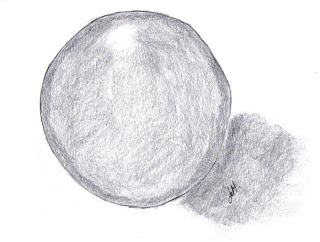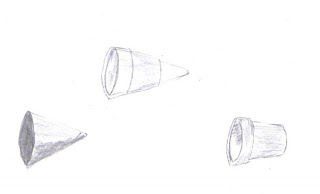Most objects that we are likely to want to draw can be visually simplified into three basic shapes: cube, cone and sphere (plus any combination of these shapes).
Training yourself to see these shapes contained within your subjects makes it considerably easier for you to start to draw them, so it is worth practising. In addition, the whole idea of translating three-dimensional objects onto a two-dimensional surface can become easier by practising shading, looking carefully at where the highlights are on an object and at the corresponding shadows.

Spheres form the basis of many vegetables, such as onions and oranges, as well as vases, ornaments and even fish paraphernalia. The highlight here is usually circular and can normally be seen towards the top, where the natural light is reflected.

 The cube is the basis for objects as diverse as matchboxes, radios and garden sheds - only the scale differs. Unlike the two curved objects, a cube has clearly defined shading, usually light on top, medium tone on one side and a darker tone on the other visible side.
The cube is the basis for objects as diverse as matchboxes, radios and garden sheds - only the scale differs. Unlike the two curved objects, a cube has clearly defined shading, usually light on top, medium tone on one side and a darker tone on the other visible side.
Studying light is also a valuable activity. Whilst writers and philosophers spend much time simply thinking, so artists spend much time just looking. The key is to mentally absorb what you see and be prepared to apply this to situations where you have to rely on your visual memory due to lack of appropriate lighting.
Finally, once you have mastered the skill of visualizing everyday objects as being constructed from individual spheres, cones and cubes, start to seek combinations to develop your own personal ‘toolbox’.
From Cone to Flowerpot

A cone can become the base shape for many objects, in this case, a flowerpot. Try to ensure that there are no points on the base: a smooth, unbroken line should curve round at the places where the straight lines meet in.
Next, start to construct the shape of the object that you wish to develop into a drawing around the base shape.
The base shape has now served its purpose and can be removed, leaving the ‘moulded’ shape of the flowerpot looking three-dimensional and thoroughly convincing.


0 comments:
Post a Comment